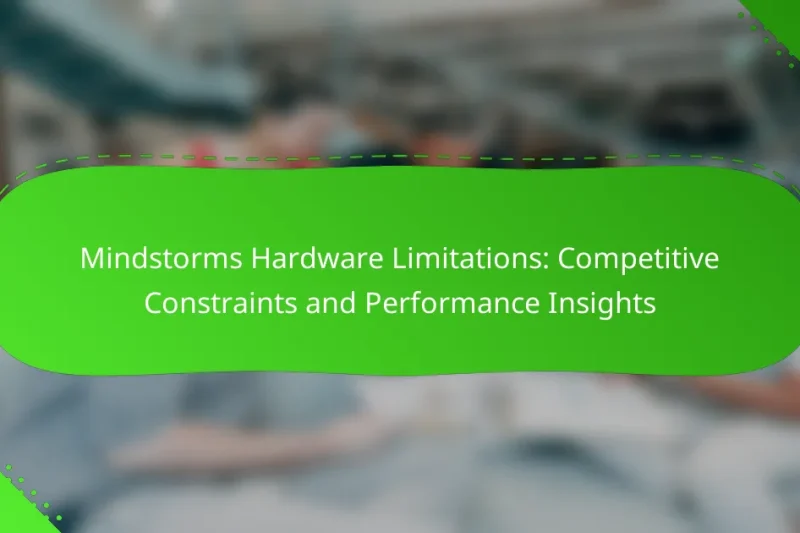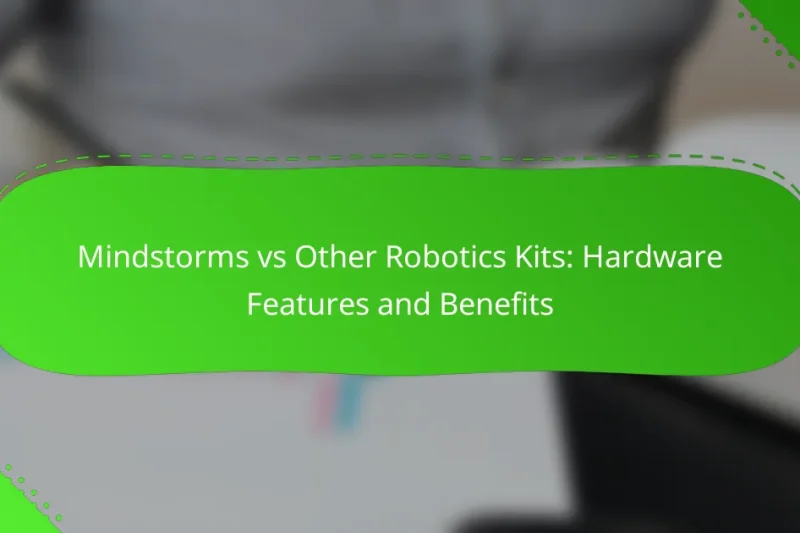Choosing compatible sensors for smart home and IoT systems is crucial for achieving optimal performance and … Compatible Sensors: Selection Criteria, Performance Metrics and Integration TipsRead more
Mindstorms Robotics Software: Hardware Compatibility
The Mindstorms Robotics Software is designed to work with a variety of hardware, primarily LEGO’s robotics kits and select third-party devices. Understanding the compatibility and connection methods is essential for optimizing the software’s functionality and ensuring effective communication between components.
Mindstorms Add-Ons: Enhancements, Compatibility and User Experience
Mindstorms add-ons are essential tools that significantly enhance the functionality and creativity of your robotics projects. … Mindstorms Add-Ons: Enhancements, Compatibility and User ExperienceRead more
Budget-Friendly Hardware: Options, Cost-Effectiveness and Project Suitability
Exploring budget-friendly hardware options can significantly enhance your projects without breaking the bank. From refurbished laptops … Budget-Friendly Hardware: Options, Cost-Effectiveness and Project SuitabilityRead more
Mindstorms Hardware Limitations: Competitive Constraints and Performance Insights
The hardware limitations of Mindstorms, including processing power, sensor compatibility, and battery life, play a crucial … Mindstorms Hardware Limitations: Competitive Constraints and Performance InsightsRead more
Mindstorms vs Other Robotics Kits: Hardware Features and Benefits
Mindstorms distinguishes itself from other robotics kits with its advanced hardware features, such as powerful motors, … Mindstorms vs Other Robotics Kits: Hardware Features and BenefitsRead more
What are the compatible hardware options for Mindstorms Robotics Software?
The Mindstorms Robotics Software is compatible with a range of hardware options, primarily focusing on LEGO’s own robotics kits and select third-party devices. Understanding these options is crucial for maximizing the software’s capabilities and ensuring seamless integration.
LEGO Mindstorms EV3
The LEGO Mindstorms EV3 is one of the primary hardware platforms for the Mindstorms Robotics Software. It features a programmable brick, motors, and sensors that allow for complex robotic designs. The EV3 system supports various programming languages and offers a user-friendly interface, making it suitable for both beginners and advanced users.
When using the EV3, ensure that you have the latest firmware updates to enhance compatibility and performance. The EV3 is widely used in educational settings and robotics competitions, providing a robust platform for learning and innovation.
LEGO Mindstorms NXT
The LEGO Mindstorms NXT is an earlier version of the Mindstorms platform, which still remains compatible with the Mindstorms Robotics Software. Although it has fewer features compared to the EV3, it includes a programmable brick, motors, and sensors that can be utilized for various robotic projects.
While the NXT may not support some of the advanced features available in the EV3, it is still a viable option for users looking to explore basic robotics. Users should consider the limitations in processing power and sensor options when choosing the NXT for their projects.
Third-party sensors
Mindstorms Robotics Software supports a variety of third-party sensors, which can enhance the functionality of LEGO robots. These sensors can include ultrasonic, infrared, and touch sensors from different manufacturers, expanding the capabilities of your robotic creations.
When selecting third-party sensors, verify their compatibility with the Mindstorms platform and check for any required adapters. Using high-quality sensors can significantly improve the performance and responsiveness of your robots.
Motor controllers
Motor controllers are essential for managing the motors used in LEGO Mindstorms robots. The Mindstorms Robotics Software is compatible with various motor controllers that can provide more precise control over motor functions, such as speed and direction.
When integrating motor controllers, ensure they are compatible with the specific LEGO motors you are using. This compatibility is crucial for achieving optimal performance and avoiding potential issues during operation.
PC and Mac compatibility
The Mindstorms Robotics Software is designed to work on both PC and Mac systems, providing flexibility for users regardless of their preferred platform. The software can be downloaded and installed on Windows and macOS, allowing for easy programming and project management.
For the best experience, check the system requirements before installation to ensure your computer meets the necessary specifications. Regular updates to the software can also enhance compatibility and introduce new features, so keeping the software up to date is advisable.
How to integrate Mindstorms Robotics Software with different hardware?
Integrating Mindstorms Robotics Software with various hardware involves understanding compatibility and connection methods. Proper setup ensures seamless communication between the software and hardware components, enhancing functionality and performance.
Connection methods
Mindstorms Robotics Software can connect to hardware through several methods, including USB, Bluetooth, and Wi-Fi. USB connections are typically the most stable and straightforward, while Bluetooth and Wi-Fi offer more flexibility for remote control and programming.
For Bluetooth, ensure that both the Mindstorms device and the computer or mobile device are paired correctly. Wi-Fi connections may require configuring network settings to ensure the devices are on the same network.
Setup process
To set up Mindstorms Robotics Software with hardware, start by installing the software on your computer or device. Follow the on-screen instructions to connect your Mindstorms hardware using the chosen method.
Once connected, you may need to update firmware on the Mindstorms device to ensure compatibility with the latest software features. Check the official website for any updates or patches that may be required.
Common issues and fixes
Common issues during integration include connectivity problems, software crashes, and hardware recognition failures. If the software does not recognize the hardware, check the connection method and ensure that all drivers are installed and up to date.
If you experience connectivity issues, try restarting both the Mindstorms device and the computer. Additionally, ensure that no other devices are interfering with the Bluetooth or Wi-Fi connection.
What are the key features of Mindstorms Robotics Software?
Mindstorms Robotics Software offers a range of features that enhance the programming and control of robotic systems. Key aspects include support for multiple programming languages, an intuitive user interface, and robust simulation capabilities that facilitate testing and development.
Programming languages supported
The Mindstorms Robotics Software supports various programming languages, primarily focusing on graphical programming through its drag-and-drop interface. Additionally, it allows users to utilize languages such as Python and C, catering to both beginners and advanced users. This flexibility enables a wide range of projects, from simple tasks to complex robotics applications.
User interface design
The user interface of Mindstorms Robotics Software is designed for accessibility and ease of use, featuring a visually appealing layout that simplifies navigation. Users can easily access tools and resources, making it suitable for educational environments. The interface also supports real-time feedback, allowing users to see the effects of their programming choices immediately.
Simulation capabilities
Mindstorms Robotics Software includes simulation features that allow users to test their robotic designs in a virtual environment before deploying them in the real world. This capability is crucial for debugging and optimizing code, as it helps identify potential issues without the risk of damaging hardware. Users can simulate various scenarios, enhancing the learning experience and improving project outcomes.
What are the prerequisites for using Mindstorms Robotics Software?
To use Mindstorms Robotics Software effectively, you need compatible hardware and specific system requirements. Ensuring your setup meets these prerequisites will enhance your experience and functionality.
System requirements
The Mindstorms Robotics Software typically requires a computer running Windows or macOS. For Windows, a system with at least 4 GB of RAM and a dual-core processor is recommended, while macOS users should have a recent version of the operating system with similar specifications.
Additionally, a stable internet connection is essential for downloading updates and accessing online resources. Make sure your device has sufficient storage space, ideally several gigabytes, to accommodate the software and any additional files you may need.
Required accessories
To fully utilize Mindstorms Robotics Software, you will need the LEGO Mindstorms kit, which includes the programmable brick and various sensors and motors. Ensure that you have the latest version of the kit, as older models may not be fully compatible with the software.
Other useful accessories include a USB cable for connecting the programmable brick to your computer and a set of batteries or a rechargeable battery pack to power the brick. Having these accessories on hand will streamline your setup and allow for uninterrupted programming and testing.
How does Mindstorms Robotics Software compare to other robotics platforms?
Mindstorms Robotics Software is user-friendly and designed for educational purposes, making it accessible for beginners. Compared to other platforms, it offers a unique blend of visual programming and hardware integration, which can be particularly appealing for younger users and educators.
VEX Robotics
VEX Robotics provides a more advanced platform aimed at competitive robotics. It supports multiple programming languages, including VEXcode and RobotC, which allows for greater flexibility and complexity in projects. While Mindstorms is often more straightforward for beginners, VEX can be more suitable for users looking to engage in competitive robotics or more complex programming tasks.
Consider the cost when choosing between these platforms; VEX kits can range from a few hundred to over a thousand USD, depending on the components included. Mindstorms kits are generally more affordable, making them a good entry point for educational settings.
Arduino IDE
Arduino IDE is an open-source platform that allows for extensive customization and programming flexibility. Unlike Mindstorms, which uses a block-based programming approach, Arduino requires users to write code, making it more suitable for those with some programming experience. This can lead to a steeper learning curve but offers greater control over hardware.
When using Arduino, users should be aware of the need for additional components like sensors and motors, which can add to the overall cost. However, the community support and resources available for Arduino are vast, making it a popular choice among hobbyists and educators alike.
RoboBlockly
RoboBlockly is a web-based visual programming tool that allows users to create programs for various robotics platforms, including Mindstorms. It is particularly useful for teaching programming concepts without the need for extensive coding knowledge. This makes it a great complement to Mindstorms, especially in educational environments.
RoboBlockly’s integration with different hardware means that users can experiment with various robots while learning programming. However, it may lack some of the advanced features and hardware integration that Mindstorms offers, making it less suitable for more complex robotics projects.
What are the future trends in Mindstorms Robotics Software compatibility?
Future trends in Mindstorms Robotics Software compatibility focus on enhanced integration with diverse hardware platforms and improved user experiences. As technology evolves, compatibility with various sensors, motors, and controllers will expand, enabling more complex and versatile robotics projects.
Emerging hardware integrations
Emerging hardware integrations in Mindstorms Robotics Software are set to revolutionize how users interact with robotics. New sensors and actuators, such as advanced cameras and IoT devices, are increasingly being supported, allowing for more sophisticated functionalities like real-time data processing and remote control.
For instance, integrating Raspberry Pi or Arduino boards with Mindstorms can significantly enhance processing power and expand the range of compatible sensors. Users can leverage these platforms to create custom solutions tailored to specific project requirements, offering flexibility in design and functionality.
When considering hardware integrations, ensure that the components are compatible with the Mindstorms software environment. Check for available libraries and support documentation to avoid common pitfalls, such as mismatched communication protocols or unsupported features.




